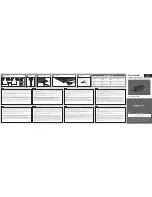
6
Working digitally
If you have only worked with film before, you will find that working with a digital back is
not so very different in many ways. Several changes in routine are needed and a certain
amount of experience with digital products and computers is advantageous to lower the
learning curve at the beginning. However, practically all of your analogue photographic
knowledge is still relevant to achieve optimum results.
The following is in no way intended to be a digital primer but simply aims to highlight some
main differentiating points to get started. There are many excellent books on the market
that explain in great detail the various aspects of digital photography and post-capture
processing.
1. It is essential to ensure you have a fully-charged battery, a spare fully-charged bat-
tery, access to battery recharging or access to a computer, depending on how you
work. Remember too that a film magazine can act as a reserve for emergencies.
2. The digital back has an internal rechargeable battery to retain the correct Time &
Date settings which appear on files and file folders to assist sorting and archiving.
This battery is automatically charged by the main battery or FireWire cable when
the back remains ON. It is important, therefore, to regularly attach a charged
battery or connect a FireWire cable for a few hours once a week or so, when the
camera is not in regular use. For this purpose, the back should be left ON and, in
the case of a FireWire connection, ensure that the computer remains active and
not set to ‘power down’ mode.
3. If you intend to work with a CF card, you must ensure you either have enough
capacity on the card for the job in hand or have access to a card reader/separate
hard disk/computer to off-load the images.
4. The sensitivity (“ISO /film speed”) of the sensor can be altered according to circum
-
stances just as you would choose a fast or slow film, thereby providing a range of
“speeds”. Just as with film, the lower “speed” settings produce finer quality.
5. Always check the three basic settings before starting:
• ISO (“film speed”)
• White balance (color temperature)
• Media (where the captured images will be stored).
6. Remember the size of the sensor causes an ‘increase’ in the focal length of lenses
in practical terms. Compose within the masking on the focusing screen.
7. Remember there can be specific restrictions regarding longer exposure times and
working with flash/strobe.
8. The OLED screen produces an image as a visual guide only. A histogram display
will provide you with the technical information about the optimum exposure.
9. Minor color casts on the preview screen can be ignored as there are opportunities
to adjust the files later in processing.
10. Be extra aware when photographing surfaces with a small regular pattern in the
coloring or structure (for example, fine-weave fabrics) as a moiré effect can be
produced in certain circumstances.
11. Most other usual photographic practices apply such as using a lens shade, using
a tripod when you can, checking for depth of field etc. However good your post-
capture skills are on the computer, for optimum results you should still aim for
optimum image capture!
Francis Hills
Fashion
created using liveBooks, www.live-books.com
copyright Francis Hills
Summary of Contents for CF DIGITAL CAMERA BACK RANGE
Page 1: ...User Manual Hasselblad CF Digital Camera Back Range ...
Page 32: ...32 Menu structure Items on the main menu ...
Page 68: ...Addendum V2 to User Manuals 2007 H1 H1D H2 H2D H3D 503CWD CFV CF 2007 09 20 V2 ...
Page 74: ...Software Reference FlexColor 4 0 for Camera Backs by Hasselblad Imacon ...
Page 85: ...Software Reference FlexColor 4 0 for Camera Backs Introduction 12 ...
Page 93: ...Software Reference FlexColor 4 0 for Camera Backs FlexColor Menus 20 ...
Page 127: ...Software Reference FlexColor 4 0 for Camera Backs The Preferences Window 54 ...
Page 133: ...Software Reference FlexColor 4 0 for Camera Backs FlexColor ICC Profiles 60 ...
Page 143: ...Software Reference FlexColor 4 0 for Camera Backs The Thumbnails Window 70 ...
Page 155: ...Software Reference FlexColor 4 0 for Camera Backs The Exposure Window 82 ...
Page 159: ...Software Reference FlexColor 4 0 for Camera Backs Active and Reload Buttons 86 ...
Page 165: ...Software Reference FlexColor 4 0 for Camera Backs The Gradations Window 92 ...
Page 177: ...Software Reference FlexColor 4 0 for Camera Backs The Texture Window 104 ...
Page 183: ...Software Reference FlexColor 4 0 for Camera Backs The Live Video Window 110 ...
Page 185: ...Software Reference FlexColor 4 0 for Camera Backs The Tasks Window 112 ...
Page 189: ...Software Reference FlexColor 4 0 for Camera Backs Appendix 116 Keyboard Shortcuts ...







































